corns > warts > callus > athletes foot > smelly feet > ingrown toenail > thickened nails > fungal nail
Corns (Heloma Durum)
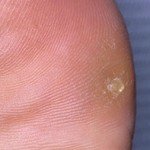
Warts (Verrucae Plantaris)
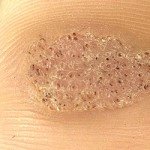 Warts are similar in appearance to corns though are not a result of friction, rather the human papilloma virus (HPV). Often they are transmitted when walking barefooted on a contaminated surface. A public shower or locker room is a common location for infection to occur. The wart needs to be removed through gentle debridement (shaving) of its surface layers followed by the use of liquid nitrogen and salicylic acid. All three methods are required as warts can be quite stubborn. The number of consultations required for resolution is dependant on the size and depth of the wart.
Warts are similar in appearance to corns though are not a result of friction, rather the human papilloma virus (HPV). Often they are transmitted when walking barefooted on a contaminated surface. A public shower or locker room is a common location for infection to occur. The wart needs to be removed through gentle debridement (shaving) of its surface layers followed by the use of liquid nitrogen and salicylic acid. All three methods are required as warts can be quite stubborn. The number of consultations required for resolution is dependant on the size and depth of the wart.
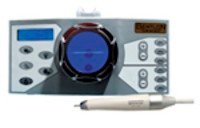
Callus (Hyperkeratosis)
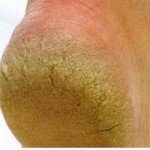 Callus is flat thickened layers of dead skin commonly found around the heels and under the forefoot. In some cases the callus may harden to the point that it may develop splits known as fissures. Fissures can lead to breakdown of the underlying skin leaving the area open to infection. Although callus is the body’s natural response to friction and pressure, excessive amounts lead to discomfort whilst walking. The podiatrist removes the callus through gentle debridement (shaving) followed by buffing of the skin with a specialised podiatry drill to produce a smooth surface. You will then be educated on possible causes and offered ongoing management advice.
Callus is flat thickened layers of dead skin commonly found around the heels and under the forefoot. In some cases the callus may harden to the point that it may develop splits known as fissures. Fissures can lead to breakdown of the underlying skin leaving the area open to infection. Although callus is the body’s natural response to friction and pressure, excessive amounts lead to discomfort whilst walking. The podiatrist removes the callus through gentle debridement (shaving) followed by buffing of the skin with a specialised podiatry drill to produce a smooth surface. You will then be educated on possible causes and offered ongoing management advice.
Athletes Foot (Tinea Pedis)
 Tinea is a fungal skin condition that often presents as a red, itchy and flakey lesion. Like warts, it is often transmitted via walking barefooted over a contaminated surface. It can be present on a variety of areas on the foot though most commonly between the toes. Treatment requires the use of anti-fungal creams, powders or sprays pending on the location. Initially this needs to be combined with regular salt water foot baths and thoroughly drying the feet after showering. Other occupational and lifestyle factors will be discussed between you and your podiatrist.
Tinea is a fungal skin condition that often presents as a red, itchy and flakey lesion. Like warts, it is often transmitted via walking barefooted over a contaminated surface. It can be present on a variety of areas on the foot though most commonly between the toes. Treatment requires the use of anti-fungal creams, powders or sprays pending on the location. Initially this needs to be combined with regular salt water foot baths and thoroughly drying the feet after showering. Other occupational and lifestyle factors will be discussed between you and your podiatrist.
Smelly Feet
Foot odour is associated with excessive sweat production causing a bacterial infection . Treatment of this condition requires management of the sweat production and addressing the bacterial infection. Your podiatrist will discuss anti-bacterial products as well as educating you about lifestyle modification to prevent ongoing recurrence.
Ingrown toenail (Onychocryptosis)
As the name suggests, an ingrown toenail is a painful condition whereby the nail grows into the skin at the side of the nail. This penetration of the skin leaves the area open to  bacterial infection. Common causes include ill fitting footwear, cutting the nail to short, trauma & genetic predisposition due to inherited nail shape. Treatment requires gentle removal of the offending section of nail, often referred to as a spicule. The site is then packed in an attempt to train the nail to grow in a manor so as to prevent future ingrowns. In the event these conservative methods fail a minor surgical procedure known as a partial nail avulsion (PNA) may be performed in the clinic under local anaesthetic. This technique involves removing a small longitudinal section of nail followed by cauterisation of the growth cells. Any current infection will also need to be addressed by topical antispetics and/or oral anti-biotics.
bacterial infection. Common causes include ill fitting footwear, cutting the nail to short, trauma & genetic predisposition due to inherited nail shape. Treatment requires gentle removal of the offending section of nail, often referred to as a spicule. The site is then packed in an attempt to train the nail to grow in a manor so as to prevent future ingrowns. In the event these conservative methods fail a minor surgical procedure known as a partial nail avulsion (PNA) may be performed in the clinic under local anaesthetic. This technique involves removing a small longitudinal section of nail followed by cauterisation of the growth cells. Any current infection will also need to be addressed by topical antispetics and/or oral anti-biotics.
Thickened Nails (Onychogryphosis)
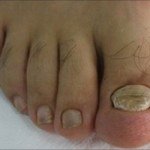 Thickened toenails can be the source of discomfort due to the increased pressure they can apply to the nailbed whilst wearing shoes. It can make cutting of the nail very difficult and painful. Your podiatrist uses a specialised Bentlon Gold podiatry drill to painlessly reduce the thickness of the toenail. After this point the nail can be trimmed painlessly.
Thickened toenails can be the source of discomfort due to the increased pressure they can apply to the nailbed whilst wearing shoes. It can make cutting of the nail very difficult and painful. Your podiatrist uses a specialised Bentlon Gold podiatry drill to painlessly reduce the thickness of the toenail. After this point the nail can be trimmed painlessly.
Fungal Nail (Onychomycosis)
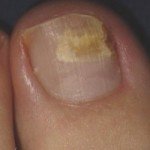 crumble when cut. Colouration of fungal nail varies pending on the type of organism present, though most commonly they have a yellowish appearance. This can be organised in streaks or a circular, mottled mass. The infection may start at the cuticle, sides or end of the nail. In early stages of infection topical treatments can be effective after the nail has been thinned by your podiatrist. In more advanced stages where the nail bed is infe
crumble when cut. Colouration of fungal nail varies pending on the type of organism present, though most commonly they have a yellowish appearance. This can be organised in streaks or a circular, mottled mass. The infection may start at the cuticle, sides or end of the nail. In early stages of infection topical treatments can be effective after the nail has been thinned by your podiatrist. In more advanced stages where the nail bed is infe
